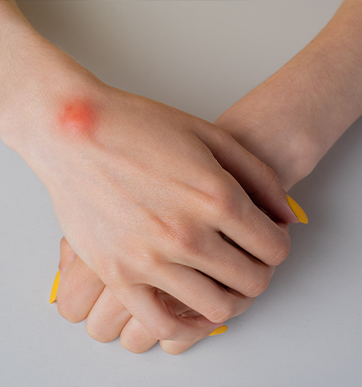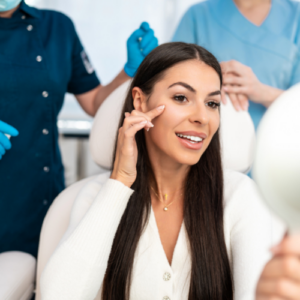
Why You Need Medical Assist with a Cyst
You’re washing dishes or pouring yourself a cup of coffee when suddenly you see something on your hand that shouldn’t be there — an odd, rounded, fleshy bump. Perhaps it’s on your wrist or a knuckle. It’s too big to be a pimple and too squishy to be a wart or a bug bite. What could it be? It might be a cyst.
Is a Cyst Dangerous?
A cyst may look scary, but it’s not. Most cysts are not cancerous and are unlikely to be malignant. A cyst is not contagious like a wart. It is not caused by an allergic reaction like hives. You can get a cyst at any age, and it’s not caused by cumulative sun exposure like skin cancer. Cysts happen for different reasons. With proper treatment, they are usually one-time occurrences with no lingering effects.
Untreated, a cyst may go away by itself. Or maybe not. It could keep hanging around, or it could turn into an infected skin abscess known as a “boil.” Treatment for cysts is covered by nearly all types of health insurance. So your best bet is to get a cyst professionally seen by a board-certified dermatologist. Cysts come in many varieties and the trained eye of a dermatologist can diagnose which type you have.
Types of Cysts on the Skin
We’re focusing here on cysts that occur on the surface of the skin. It is important to note that cysts can also occur inside the body on the epithelial surfaces of internal organs. For example, women may develop ovarian cysts. Internal cysts can be painful. It is important to have them treated by a health care provider who specializes in the care of the affected organ.
Ganglion Cyst
This is one of the most common types of cysts. The word “ganglion” means knot and is used to describe the mass that forms below the surface of the skin. A ganglion cyst is often found over a joint or a tendon of the hand or wrist. The ganglion cyst forms when there is a small tear in the inner thin tissue covering a joint or tendon. The tissue bulges and forms a sac. Fluid from the joint leaks into the sac causing swelling. A ganglion cyst may result from possible exercise or other activity-related trauma. It can be painful if it is pressing on a nerve.
Epidermoid Cyst
An epidermoid cyst is another frequently occurring type of cyst. It has a smooth surface and may appear flesh-colored, whitish or yellowish in color. It may also have a central point like that of a blackhead. An epidermoid cyst may feel more solid than a ganglion cyst. That’s because it is filled with keratin, a body-produced type of protein that helps make up the protective layer of skin, hair and nails. But too much of a good thing can be a problem. If your body produces an excess of keratin, a cyst may form typically on the face, neck, or back.
Pilar Cyst
This type of cyst is similar to an epidermoid cyst. The major difference is that pilar cysts involve a keratin overload due to hair follicles and thus appear typically on the scalp. A pilar cyst can gradually develop in the epithelial lining of a hair follicle. This lining contains keratin. Over time, if the protein continues to build up in the hair follicle, it turns into the bump that’s characteristic of a pilar cyst. Pilar cysts may have a hereditary component.
Ingrown Hair Cyst
Like a pilar cyst, an ingrown hair cyst involves hair. But that is where the similarity ends. An ingrown hair cyst does not involve a buildup of excess keratin. Instead, it starts with a hair that for some reason — maybe from being shaved or plucked — turns in on itself and attempts to keep growing under the skin. Sensing an intruder, the body’s immune system activates. The resulting inflammatory processes can cause swelling, redness, tenderness and possibly the development of pus under the skin. In addition to the scalp, ingrown hair cysts tend to occur in the groin or armpit where the warm enclosed environment can enhance their growth.
Pilonidal Cyst
You might think this is an odd cyst, because it emerges only on the tailbone. Yet, over 70,000 Americans a year develop a pilonidal cyst. During World War II, it was called “jeep drivers’ cyst.” Now, it is often called “truck drivers’ cyst.” Anyone who plays a sport that involves long periods of sitting on the bench may also get it. Sitting for long periods of time, especially in a warm environment that causes perspiration, and especially if tight clothing is worn, makes you a potential candidate for a pilonidal cyst. Droplets of sweat may pool in the small dark cavity atop the buttocks, trapping shedding skin cells amid body hairs, triggering the growth of the cyst.
Cystic acne
Are those reddened bumps on your teenager’s face and back acne or cysts? Actually, they’re both. And it’s not uncommon. Over 3 million teens and young adults seek treatment every year from a dermatologist for this issue. When pores become clogged from overproduction of skin oils mixing with skin cells and bacteria, they can become infected, leaving red swollen bumps. Stress during this hormonally sensitive time of life is thought to also play a role. Because of its dual etiology and location of the face, dermatologists tend to treat cystic acne with a combination of topical and oral prescription medications instead of excision surgery, the optimal treatment for most other kinds of cysts.
Getting Rid of a Cyst
While a cyst may rarely go away on its own, it isn’t likely. And although a cyst may not be dangerous so long as it’s not infected, it isn’t particularly pleasant to have one. So why endure it when it can be treated by a board-certified dermatologist?
Several treatment options exist. Which one is best for you will depend on the type of cyst you have, the location of the cyst and whether it is infected.
A minor surgical procedure called excision is the best treatment for most cysts, with the exception of cystic acne. Excision involves removing the entire cyst, and virtually ensures that it won’t come back. Laser removal also may be an option.
For some cysts, especially those involving infection and inflammation, other types of treatment may be needed. Treatment options may include injecting the cyst with steroid medication, oral antibiotics or draining the cyst.
Under no circumstances should you attempt to remove a cyst yourself due to risks of infection and scarring. Plus, it is unlikely you will be able to remove the cyst wall, which is a solid bit of skin tissue, and may, if it remains, cause a cyst to regrow.
For top quality medical diagnosis and treatment of cysts, request an appointment at a California Skin Institute office near you.



 / 291 Reviews
/ 291 Reviews